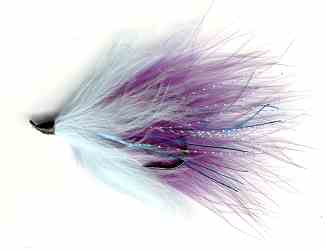Purple and Blue Alaskabou Winter Steelhead Marabou Streamer
Jack Gartside designed the Alaskabou streamer to catch early spring and winter Steelheads. These magnificent fish are simply migratory rainbow trout. (A Sea Trout is the migratory form of the brown trout).

WINTER STEELHEAD ALASKABOU FLY PATTERNS. Hook size 2/0 - $US each
They spawn in freshwater rivers and lakes, remain there for about two years, then migrate to the open sea where they will stay for another two to three years before they begin returning to their native rivers. Steelheads returning to their home rivers, will be fully mature and weigh between seven and ten pounds. Fish that have stayed in the ocean longer can reaching impressive sizes of 12 to 20 pounds or more. Unlike the migratory salmon, not all sea-run steelhead die immediately after spawning. About twenty percent of each steelhead generation that returns to freshwater to spawn make their way back down the rivers and into the sea again. Not many will be strong enough to make a second spawning run.
Steelheads in the sea look very much like river trout until they begin their migration when they change to a bright silver, their backs a darker grey. Anglers call these trout "chrome bright," or "chromers." After they have been in freshwater for a time, however, steelhead slowly begin to take on the color patterns of true rainbow trout, with various patterns of black spots sprinkled across their backs, complete with smears of red on the cheeks, with distinctive red stripes marking their flanks. These red stripes can range in color from soft coral pink to a deeper blood-red color. The males fish are more colorful. Migrations continue throughout the year, although the most active steelhead months are December, January, and March for winter steelhead; and June through August for the summer runs. Most steelhead rivers have only a summer or a winter run; some have both, and some experience no spring or summer steelhead runs at all hosting an autumn/fall and winter-run trout. It is mostly the big rivers, that have steelhead runs year-round.
Winter-run steelhead become very single minded. It is the greatest run of trout in terms of numbers. All their energy is devoted to spawning. For the most part, when they do feed, or strike a fly, they seem to do so out of habit and instinct rather than true hunger. It is this instinct - the steelhead's curiosity that can work to the angler's advantage. They will still strike at a well-presented artificial fly. They are also exceptionally wary, nervous, and incredibly difficult to catch. Winter steelhead seem to be, by far, the spookiest of the migratory steelhead. In shallow, clear water. Even the hint of a shadow moving across the water startles them, sending them scurrying.
The spring and summer trout runs produce the highest quality of steelheads, in looks and sport. They are still sexually immature when they enter the rivers. They will spend more time in freshwater before they begin spawning. Most winter-run steelhead will spawn quickly and then return to the ocean, some do linger in the rivers throughout the winter and into the spring. Spring and summer-run trout will often remain in the rivers through the summer months. When these steelheads strike, they do so with a great deal more ferocity than winter-run trout. They fight like big saltwater fish and are one of the great game fish of the world.

